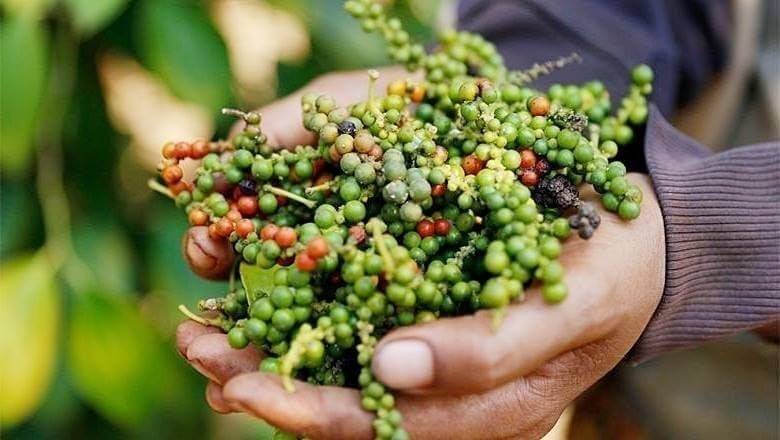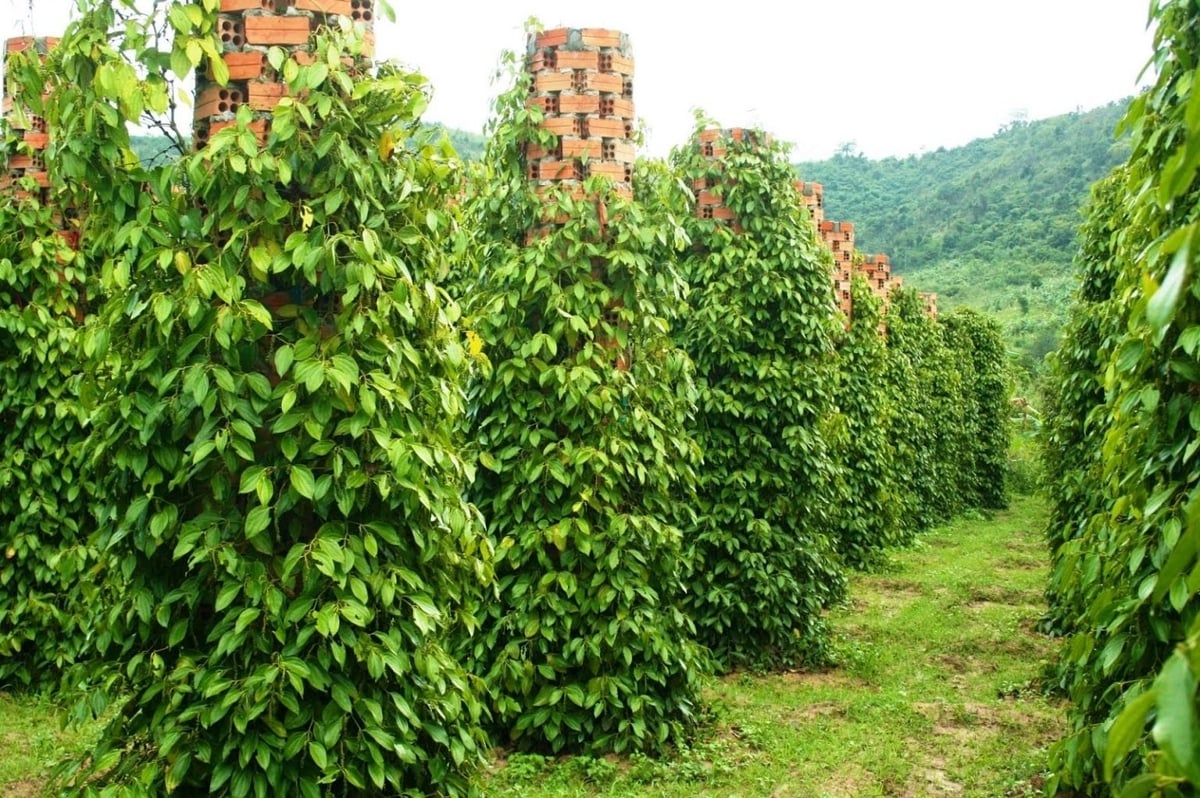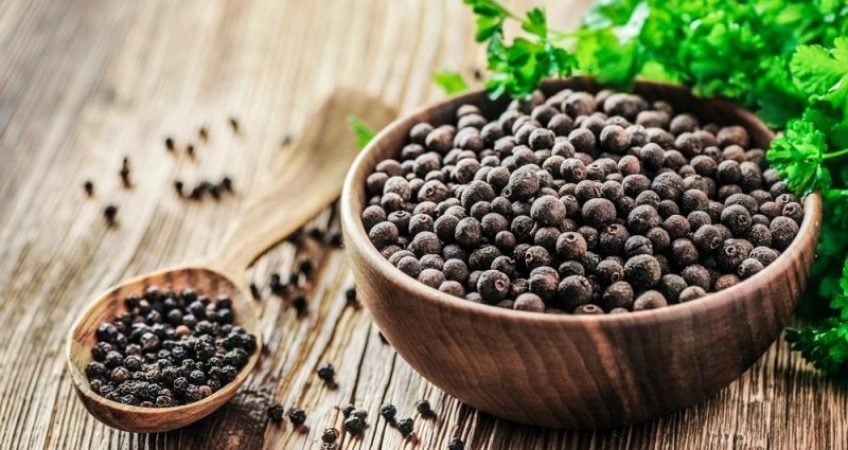December 10, 2025 | 05:52 GMT +7
December 10, 2025 | 05:52 GMT +7
Hotline: 0913.378.918
December 10, 2025 | 05:52 GMT +7
Hotline: 0913.378.918
According to the Vietnam Pepper and Spice Association (VPSA), in February 2025, Vietnam exported 14,331 tons of pepper, worth USD 97.3 million, up 5.4% in volume and 77.5% in value over the same period in 2024. Of which, black pepper reached 11,858 tons, white pepper reached 2,473 tons.
In the first two months of 2025, Vietnam exported 27,416 tons of pepper, worth USD 184.9 million, down 11.9% in volume but up 48.1% in value over the same period in 2024. Of which, black pepper reached 22,360 tons, and white pepper reached 5,056 tons.

Pepper exports aim for a record of USD 1.5 billion in 2025.
The average export price of pepper in the first two months of 2025 reached USD 6,746 per ton, up 68.2% over the same period in 2024. In February 2025 alone, the average export price of pepper reached USD 6,788 per ton, up 68.5% over the same period in 2024. It is also the highest price in the past 8 years since February 2017.
The United States continued to be the largest importer of Vietnamese pepper in the first two months of the year, with 5,890 tons, down 32.7% over the same period in 2024 and accounting for 21.5% of the market share. Germany, India, and China followed. China alone saw an 86.6% increase in import volume over the same period in 2024.
Optimistic signals from the beginning of the year led VPSA to forecast a bright year for the pepper industry. Specifically, as global pepper output is likely to continue to decline while consumption demand remains stable, Vietnamese pepper is facing a "golden opportunity" this year, creating a strong driving force to promote industry development.
In 2024, pepper export turnover reached USD 1.32 billion, with an output of 200,000 tons from 110,500 hectares and an average yield of 2.6 tons per hectare - double the world average. VPSA predicts that in 2025, pepper could reach an export value of USD 1.5 billion because Vietnam still accounts for about 40% of output and 55% of global pepper export turnover.
Three main reasons led VPSA to this assessment. Firstly, Vietnam's pepper processing technology has generally reached the standards of the world market. The country has about 200 pepper processing and trading enterprises, including 15 leading enterprises. The entire industry has 14 deep processing factories and five foreign-invested enterprises.
Most Vietnamese enterprises have high-tech processing factories according to ASTA, ESA, and JSSA standards to create diverse products such as black pepper, whole white pepper, ground pepper, and small packages suitable for many market segments.

Global pepper production is forecast to decline in 2025.
Second, Vietnam's pepper output is relatively stable. In Dak Nong, the capital of Vietnam's pepper, the output is expected to be the same as last year. In other localities, such as Gia Lai, Binh Phuoc, Dong Nai, and Ba Ria-Vung Tau, the increase in pepper prices since the beginning of the year has encouraged people to invest in caring for and restoring existing pepper gardens boldly.
Many pepper raw material areas across the country are shifting from increasing acreage to improving quality, promoting deep processing, and diversifying products to penetrate the global supply chain deeply. Some households in the Central Highlands have even boldly switched to organic production, ensuring that products meet the standards of demanding export markets.
Finally, there is productivity. Although the acreage is only 15% of coffee and 12% of rubber, pepper contributes 23% of coffee export value (USD 5.6 billion) and 38% of rubber value (USD 3.4 billion).
Nguyen Quy Duong, Deputy Director of the Department of Crop Production and Plant Protection (Ministry of Agriculture and Environment), shared: "Vietnam is blessed with favorable climate and soil conditions, creating ideal conditions for pepper plants."
A typical example is Gia Lai province, which has a large area of nutrient-rich basalt soil and a humid tropical climate. Here, pepper productivity reaches 3, and the pepper area is currently about 7,500 hectares with a yield of 3.5 tons per hectare, about 30% higher than the national average yield. It is one of the reasons why experts believe that Vietnamese pepper still has a lot of room.

Vietnam has a wide variety of pepper export products.
Despite having favorable natural conditions and many favorable factors, the pepper industry still faces significant challenges from pesticide residues, environmental issues (reducing carbon emissions), or sustainability factors when implementing intercropping models.
Recently, two shipments of black pepper exported to Taiwan were returned due to contamination with Sudan. In this market, the maximum residue level of Sudan IV is 0.01 ppm. If this level is exceeded in food, the shipment will be refused entry.
Meanwhile, in the EU, US, and Chinese markets, Sudan IV is classified as an industrial colorant and is not allowed to be used in food due to its potential risk of causing cancer.
Pepper is contaminated with this substance because people habitually use red sacks and 2-layer tarpaulins (orange and blue) to harvest, dry, and preserve the product. Due to limited information and awareness, some production areas have not had time to change their farming practices.
Another factor in the pepper industry is the issue of linkage. Production is still small-scale and fragmented, and there is a lack of connection between enterprises - farmers and farmers-processors. Not to mention the limitations of the intermediary role between the state - enterprises; market research is ineffective.
To overcome the above challenges, experts say it is necessary to diversify the market further, avoiding dependence on a few traditional markets. In addition, farming is shifting towards sustainability because world consumers, especially in the EU region, are willing to pay more for transparent and friendly products.
Translated by Huong Giang

(VAN) Despite numerous challenges, Vietnam's key seafood products are maintaining strong momentum, setting the stage for full-year exports to potentially reach USD 11 billion.

(VAN) The signing of a protocol between Viet Nam and China on the export of fresh jackfruit represents a significant milestone in agricultural trade cooperation between the two countries.

(VAN) On November 27, the Ninh Binh Department of Agriculture and Environment and the Institute for Green Growth Research organized a training course on greenhouse gas inventory for businesses.

(VAN) China’s cooking oil is suddenly flooding into India. It all comes down to a soybean surplus that Beijing doesn’t quite know what to do with.

(VAN) An Giang promotes supply-demand connections, standardizes quality and builds value chains, creating a foundation for sustainable bird’s nest development and aiming to expand exports.
/2025/11/24/5339-4-nongnghiep-075331.jpg)
(VAN) Recently, the conference on 'Sustainable Fisheries Linkage Chain - Tilapia for Export' took place in Tien Hai commune, Hung Yen province.
/2025/11/21/4309-2-153400_128.jpg)
(VAN) Green and low-emission rice is paving the way for Vietnamese rice to enter high-end markets, marking the beginning of a transformation journey toward greening and elevating the national rice brand.